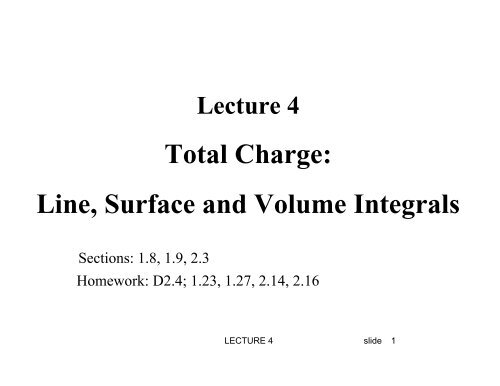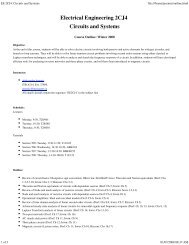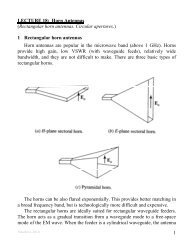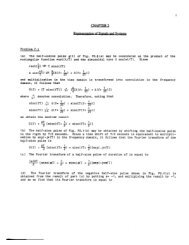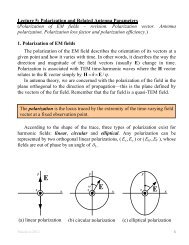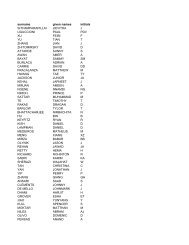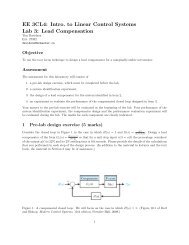Total Charge: Line, Surface and Volume Integrals
Total Charge: Line, Surface and Volume Integrals
Total Charge: Line, Surface and Volume Integrals
You also want an ePaper? Increase the reach of your titles
YUMPU automatically turns print PDFs into web optimized ePapers that Google loves.
Lecture 4<br />
<strong>Total</strong> <strong>Charge</strong>:<br />
<strong>Line</strong>, <strong>Surface</strong> <strong>and</strong> <strong>Volume</strong> <strong>Integrals</strong><br />
Sections: 1.8, 1.9, 2.3<br />
Homework: D2.4; 1.23, 1.27, 2.14, 2.16<br />
LECTURE 4 slide 1
<strong>Line</strong> Elements – 1<br />
metric increment due to the differential increment of a coordinate<br />
a y<br />
dya<br />
a<br />
y<br />
dl b<br />
dxa<br />
dl = dxa + dya<br />
x<br />
ax<br />
x y<br />
dφ<br />
aρ<br />
a dρa φ ρ<br />
a b<br />
dl<br />
ρdφaφ dl = dρa ρ + ρdφaφ<br />
LECTURE 4 slide 2
<strong>Line</strong> Elements – 2<br />
line increment is a vector → has direction: point of integration<br />
moves from point a to point b<br />
each of its components is a linear increment (in meters)<br />
RCS: dx, dy, <strong>and</strong> dz are linear by default<br />
CCS: dρ <strong>and</strong> dz are linear, dφ is not<br />
SCS: dr is linear, dθ <strong>and</strong> dφ are not<br />
example: angular increment dφ corresponds to linear<br />
increment ρdφ<br />
LECTURE 4 slide 3
CCS:<br />
dl = dρa + ρdφa + dza<br />
ρ φ<br />
SCS:<br />
dl = dra + rdθa + rsinθdφa r<br />
θ φ<br />
x<br />
<strong>Line</strong> Elements – 3<br />
z<br />
z<br />
θ<br />
dθ<br />
φ dφ<br />
r sinθ<br />
dl<br />
rdθ<br />
dr<br />
a<br />
r<br />
ar<br />
a<br />
LECTURE 4 slide 4<br />
θ<br />
φ<br />
rsinθdφ y
<strong>Line</strong> Integration: <strong>Charge</strong> on <strong>Line</strong>s – 1<br />
B<br />
Q= ∫ ρldl<br />
A<br />
the direction of integration does<br />
not matter: charge is scalar<br />
SPECIAL CASES: CHARGE ON COORDINATE GRID LINES<br />
straight line: choose RCS xB<br />
axis along charged line Q= ∫ ρl<br />
( x) dx<br />
φ-line in CCS: circular<br />
φB<br />
charges in the x-0-y plane Q= ∫ l ( ) ⋅ 0d<br />
θ-line <strong>and</strong> φ-line in SCS<br />
x<br />
φ<br />
A<br />
A<br />
ρ φ ρ φ<br />
θB<br />
φB<br />
∫ ρl ( θ) 0 θ = ∫<br />
l ( ) ⋅ 0sin 0<br />
θ<br />
φ<br />
Q= ⋅r<br />
d<br />
Q ρ φ r θ dφ<br />
A<br />
A<br />
LECTURE 4 slide 5
x<br />
<strong>Line</strong> Integration: <strong>Charge</strong> on <strong>Line</strong>s – 2<br />
GENERAL CASE curved line: need line equation in parametric form<br />
r( u) = x( u) ax+ y( u) ay + z( u)<br />
az ⇒ dl= dr = dxax+ dyay + dzaz<br />
2 2 2 2<br />
⇒ dl = dx + dy + dz<br />
dl<br />
⇒<br />
⎛ ⎞<br />
⎜ ⎟<br />
⎝du ⎠<br />
dx<br />
=<br />
⎛ ⎞<br />
⎜ ⎟<br />
⎝du ⎠<br />
⎛ dy<br />
+<br />
⎞<br />
⎜ ⎟<br />
⎝du ⎠<br />
⎛ dz<br />
+<br />
⎞<br />
⎜ ⎟<br />
⎝du ⎠<br />
2<br />
⎛ dl ⎞ dr dr<br />
⇒ ⎜ ⎟ = ⋅<br />
⎝du ⎠ du du<br />
z<br />
dl<br />
⇒<br />
⎛ ⎞<br />
⎜ ⎟=<br />
⎝du ⎠<br />
dr dr<br />
⋅<br />
du du<br />
⇒ dl =<br />
dr dr<br />
⋅ du<br />
du du<br />
u<br />
B<br />
dr dr<br />
LAB = ∫ ⋅ du<br />
du du<br />
uA<br />
r(<br />
u)<br />
A<br />
dr<br />
y<br />
B<br />
2 2 2 2<br />
B<br />
dr dr<br />
Q= ∫ ρl<br />
( u) ⋅ du<br />
du du<br />
LECTURE 4 slide 6<br />
u<br />
u<br />
A
<strong>Surface</strong> Elements – 1<br />
The surface element is defined by two line elements:<br />
ds= dl × dl<br />
1 2<br />
surface elements in the RCS principal planes<br />
z = const plane: ds=± dxdya<br />
y = const plane: ds=± dxdza<br />
x = const plane: ds=± dydza<br />
dl2 ds<br />
z<br />
y<br />
x<br />
dz<br />
dl<br />
dx<br />
LECTURE 4 slide 7<br />
1<br />
x = a /2<br />
dy<br />
y = −a<br />
/ 2<br />
dy<br />
z<br />
dz<br />
0 y dx<br />
x<br />
2 /<br />
x = − a /2<br />
z = −a<br />
/2<br />
a<br />
z = a<br />
/2<br />
y = a
<strong>Surface</strong> Elements – 2<br />
surface elements in the CCS principal planes<br />
ρ = const plane: ds=± ρdφdza φ = const plane: ds=± dρdzaφ z = const plane: ds=± ρdρdφaz ρ<br />
dz<br />
LECTURE 4 slide 8<br />
z<br />
z = consta<br />
z<br />
a d ρ<br />
ρdφ aφ<br />
dz aρ<br />
ρdφ dρ<br />
const<br />
φ =<br />
ρ =<br />
const
<strong>Surface</strong> Elements – 3<br />
surface elements in the SCS principal planes<br />
r = const surface (sphere):<br />
2 ds= r sinθdθdφar θ = const surface (cone):<br />
ds= rsinθdrdφaθ φ = const surface (circular plane):<br />
ds= rdrdθaφ LECTURE 4 slide 9
<strong>Surface</strong> Integration: <strong>Charge</strong> on <strong>Surface</strong>s – 1<br />
We will limit ourselves to SPECIAL CASES<br />
charges on principal coordinate planes<br />
charge on a plane<br />
y x<br />
2 2<br />
Q= ∫∫ρs(<br />
x, y) dxdy<br />
y x<br />
1 1<br />
charge on a circular disk or ring<br />
ρ φ<br />
2 2<br />
Q= ∫∫ρs(<br />
ρφρ , ) dφdρ ρ φ<br />
1 1<br />
y2<br />
y1<br />
LECTURE 4 slide 10<br />
y<br />
Q= ∫∫<br />
ρsds<br />
x<br />
ρ1<br />
S<br />
x1 x2<br />
φ2<br />
ρ2 1 φ
x<br />
<strong>Surface</strong> Integration: <strong>Charge</strong> on <strong>Surface</strong>s – 2<br />
charge on a cylinder<br />
z<br />
2<br />
2<br />
Q= ∫∫ρs<br />
(, z φρ ) 0dφdz<br />
z<br />
φ<br />
φ<br />
1 1<br />
charge on a sphere<br />
z<br />
0<br />
θ1<br />
r<br />
0<br />
θ2<br />
φ1<br />
φ2<br />
y<br />
φ θ<br />
2 2<br />
1 1<br />
ρ0<br />
2<br />
0<br />
LECTURE 4 slide 11<br />
z2 1 φ φ2<br />
z1<br />
Q= ∫∫ρs<br />
( θφ , ) r sinθdθdφ<br />
φ θ
<strong>Surface</strong> Integration: <strong>Charge</strong> on <strong>Surface</strong>s – 3<br />
charge on a cone<br />
φ2<br />
r2<br />
= ∫∫ρs (, φ)sinθ0 φ r<br />
φ<br />
r2<br />
1<br />
Q r r drd<br />
1 1<br />
NOTE: If you set ρ s = 1 in the above formulas, you can compute<br />
the area of the respective surfaces.<br />
φ<br />
r1<br />
θ0<br />
LECTURE 4 slide 12<br />
φ2
<strong>Volume</strong> Elements – 1<br />
The volume element is defined by three line elements<br />
RCS: dv = dxdydz<br />
dv = ( dl × dl ) ⋅dl<br />
1 2 3<br />
dl2<br />
dl 3 dl<br />
LECTURE 4 slide 13<br />
1
CCS: dv = ρd ρdφdz <strong>Volume</strong> Elements – 2<br />
LECTURE 4 slide 14
2<br />
SCS: dv = r sinθ<br />
drdθdφ <strong>Volume</strong> Elements – 3<br />
LECTURE 4 slide 15
parallelogram<br />
<strong>Volume</strong> Integration: <strong>Volume</strong> <strong>Charge</strong>s<br />
z y x<br />
2 2 2<br />
Q = ∫∫∫ρv(<br />
x, y, z) dxdydz<br />
z y x<br />
1 1 1<br />
cylindrical volume<br />
z<br />
1 2 2<br />
Q= ∫∫∫ρ<br />
v ( ρφ , , z) ρdρdφdz z<br />
φ ρ<br />
φ ρ<br />
1 1 1<br />
spherical volume<br />
φ θ<br />
r<br />
2 2 2<br />
Q= ∫∫∫ρv(,<br />
r θφ , ) r sinθdrdθdφ<br />
φ θ<br />
r<br />
1 1 1<br />
2<br />
Q= ∫∫∫ ρvdv<br />
NOTE: You can find the volume of the element by setting ρ v = 1.<br />
LECTURE 4 slide 16<br />
V
<strong>Volume</strong> Integration: Example<br />
A light source shines onto a hemispherical dome of radius a = 5 m,<br />
<strong>and</strong> makes a round spot 2 m in diameter, d = 2 m. What is the<br />
volume of the light cone from the light source to the dome?<br />
Work in SCS. Assume the z-axis is along the axis of the<br />
symmetrical conical light beam. The sine of the half the<br />
subtended angle of the beam is<br />
d /2<br />
sinα = = 0.2<br />
2<br />
⇒ cosα = 1− sin α =<br />
0.9798<br />
a<br />
2π<br />
α a<br />
V = ∫∫∫ dv= ∫ ∫ ∫<br />
2 r sin drd d<br />
V φ= 0θ= 0r= 0<br />
θ θ φ<br />
3 3<br />
a<br />
5<br />
V = × 2 π× (1− cos α) = × 2π× 0.0202 = 0.21, m<br />
3 3<br />
LECTURE 4 slide 17<br />
3
You have learned how to<br />
find the total charge along a straight line or any other curved line<br />
find the total charge on any portion of the surface of a plane, disk,<br />
cylinder, sphere, cone<br />
find the total charge on any portion of a parallelogram, cylinder,<br />
sphere, cone<br />
use integration to find length, area <strong>and</strong> volume<br />
LECTURE 4 slide 18


